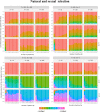Exploring the interplay between natural and intersexual selection on the evolution of a cognitive trait
- PMID: 35813909
- PMCID: PMC9251863
- DOI: 10.1002/ece3.9066
Exploring the interplay between natural and intersexual selection on the evolution of a cognitive trait
Abstract
There has been an increased focus on the role of natural and sexual selection in shaping cognitive abilities, but the importance of the interaction between both forces remains largely unknown. Intersexual selection through female mate choice might be an important driver of the evolution of cognitive traits, especially in monogamous species, where females may obtain direct fitness benefits by choosing mates with better cognitive abilities. However, the importance given by female to male cognitive traits might vary among species and/or populations according to their life-history traits and ecology. To disentangle the effects of natural and sexual selection, here we use an agent-based simulation model and compare the model's predictions when females mate with the first randomly encountered male (i.e., under natural selection) versus when they choose among males based on their cognitive trait values (i.e., under natural and intersexual selection). Males and females are characterized, respectively, by their problem-solving ability and assessment strategy. At each generation, agents go through (1) a choosing phase during which females assess the cognitive abilities of potential mates until eventually finding an acceptable one and (2) a reproductive phase during which all males compete for limited resources that are exploited at a rate, which depends on their cognitive abilities. Because males provide paternal care, the foraging success of mated males determines the breeding success of the pair through its effect on nestling provisioning efficiency. The model predicts that intersexual selection plays a major role in most ecological conditions, by either reinforcing or acting against the effect of natural selection. The latter case occurs under harsh environmental conditions, where intersexual selection contributes to maintaining cognitive diversity. Our findings thus demonstrate the importance of considering the interaction between both selective forces and highlight the need to build a conceptual framework to target relevant cognitive traits.
Keywords: cognitive performance; intersexual selection; mate choice; problem‐solving ability; provisioning ability.
© 2022 The Authors. Ecology and Evolution published by John Wiley & Sons Ltd.
Conflict of interest statement
The authors declare that they have no conflict of interest.
Figures





Similar articles
-
Smart mating: the cognitive ability of females influences their preference for male cognitive ability.Behav Ecol. 2021 Jun 22;32(5):803-813. doi: 10.1093/beheco/arab052. eCollection 2021 Sep-Oct. Behav Ecol. 2021. PMID: 34690544 Free PMC article.
-
Experimental removal of sexual selection reverses intersexual antagonistic coevolution and removes a reproductive load.Proc Natl Acad Sci U S A. 1999 Apr 27;96(9):5083-8. doi: 10.1073/pnas.96.9.5083. Proc Natl Acad Sci U S A. 1999. PMID: 10220422 Free PMC article.
-
Mate sampling influences the intensity of sexual selection and the evolution of costly sexual ornaments.J Theor Biol. 2018 Jun 14;447:74-83. doi: 10.1016/j.jtbi.2018.03.026. Epub 2018 Mar 19. J Theor Biol. 2018. PMID: 29567325
-
Sexual selection, phenotypic plasticity and female reproductive output.Philos Trans R Soc Lond B Biol Sci. 2019 Mar 18;374(1768):20180184. doi: 10.1098/rstb.2018.0184. Philos Trans R Soc Lond B Biol Sci. 2019. PMID: 30966965 Free PMC article. Review.
-
The evolution of male mate choice in insects: a synthesis of ideas and evidence.Biol Rev Camb Philos Soc. 2001 Aug;76(3):305-39. doi: 10.1017/s1464793101005693. Biol Rev Camb Philos Soc. 2001. PMID: 11569787 Review.
References
Associated data
LinkOut - more resources
Full Text Sources

